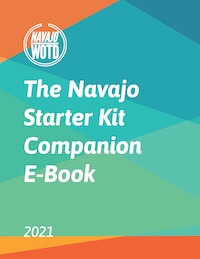ńdii'aah
pick it up
nh dee ah
Today we’re tackling a part of Navajo that is perplexing to many new Navajo speakers. It has to do with actions, and the objects towards which they are to be directed.
Ńdii’aah means commonly “pick it up (for me)”.
Here, the -‘aah stem implies that the thing that needs to be picked up is solid-bulky. There are other stems for open containers, living objects, mushy stuff, flat objects, slender and stiff, slender and flexible, and more.
The ńdii- part is the prefix for managing an object, as well as a way to determine who is being talked about.
The complexity begins when you need to recognize the different type of objects by listening to the end of the word. For example, ńdiikaah refers instead to pretty much any open container.
It gets more complicated when the prefix changes, thereby changing who the directive applies to. Ńdoh-, instead of ńdii-, is second-person dual - “you two pick it up”.
Then, you must rely on context to pin-point the actual meaning. Ńdii’aah could also refer to choosing or finding something. And, the ńdii- prefix is also the first-person dual form - “you and I pick it up”.
If you’re looking for a bigger challenge, take into account that the -aah stem is only the imperfective form (i.e. in the process of or “present tense”) The perfective (i.e. “past”) and the future forms of these stems remain (-ą́ and -‘ááł, respectively).
